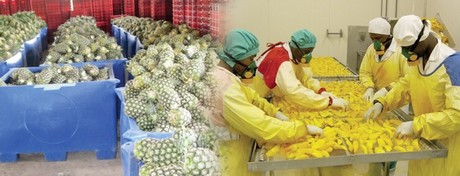Processing companies such as Blue Skies, HPW, Peelco and Pinora have had to import more than half of their raw materials such as mangoes, pineapples and papaya (pawpaw) as they struggle to source them locally. Other processing companies in Adeiso in the Eastern Region, Nsawam, Asamankese and Tema have all folded up due to lack of raw materials that can make them competitive.

Mr Abloh said Blue Skies had just sealed a deal to air-lift 120 tonnes of mangoes a week from Brazil for 10 weeks, mainly due to inadequate local supplies and from the sub-region, especially during the crop’s off seasons.
Blue Skies, which has the capacity to process 30 tonnes of fresh pineapple a day for export, is only doing 20 tonnes a day. Last month, the company laid off over 400 workers due to lack of raw materials for off peak production. HPW, a Swiss company which used to export fresh fruits from Ghana, had to make a hard U-turn to dry fruits – pineapple, mango and coconut. “Ghana’s fruit industry consists of a huge amount of small farmers, often with a weak set-up and very few large and professional fruit growers/exporters. Our demand of over 6,000 tonnes of fresh fruit is substantial for the industry,” said company officials.
Horticultural produce from Ghana has shown a lot of promise over the years. The country has been involved in the export of horticultural exports since the 1980s. Exports rose quickly from US$28 million in 2000 to US$75 million by 2006, with a lot of potential at hand, with mangoes, pineapples and chilis showing firmer promise.
Statistics indicate that there are about €1 billion worth of pineapple market; €3.5 billion for bananas and US$250 million, all in the European Union alone. Ghana’s pineapple exports blossomed in the 1990s when pineapple exports formed an association and reached an agreement with a vessel to lift fresh produce from Ghana, after visiting Cameroon and Cote d’Ivoire.
The twice a week lifting accelerated exports of fresh pineapples and other horticultural produce. Pineapple exports, thus rose from a few tonnes a week to 71,000 tonnes in 2004. The exports started slumping very fast when Costa Rica introduced the much sweeter MD2 pineapple which caught on well in the EU market. This caused the market for Ghana’s variety, the smooth cayenne, to plummet to the current low levels of 35,000 tonnes in 2012.





